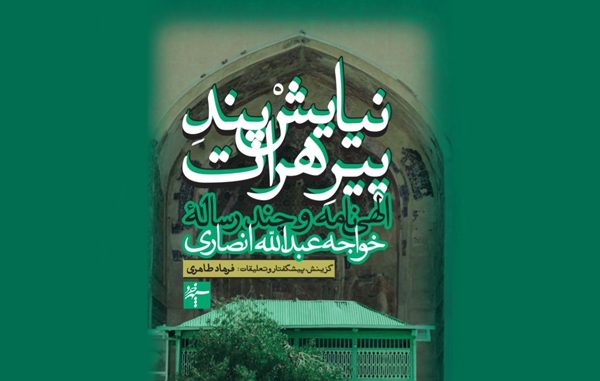
The Annotated Preaching-Prayers of Khajeh Abdullah Ansari
- Niyayesh-Pand-e Pir-e Herat: The Annotated Preaching-Prayers of Khajeh Abdullah Ansari
- Editor: Farhad Taheri
- Language: Persian
- Publisher: Sepehr-e Kherad, 2024
The present book contains a selection of writings by Khajeh Abdullah Ansari, a renowned mystic and a towering figure in the history of Iranian Sufism and Mysticism who lived and left an impact during the eleventh century (Fifth century SH). The present volume is edited by Farhad Taheri, Iranian scholar and researcher in the cultural history of contemporary Iran. The titular Persian phrase “Niyayesh-Pand” (an amalgamation of prayers to God and preaching mankind) is coined for the first time by him to replace the Arabic term “Munajat” which is widely used to refer to these writings. Taheri believes that ‘Niyayesh-Pand” is a more accurate term in Persian language than the Arabic word “Munajat”. According to him, “Niyayesh-Pand” signifies both a conversation to God and preaching men, whereas “Munajat” does not exactly reflect both aspects of the writings. Khajeh Abdullah Ansari, also known as “Pir-e Herat” (the Sage of Herat), was a person with excellent human qualities and crowds of followers, who lived in Herat of Afghanistan and guided the people of his time.
Niyayesh-Pand is composed in three parts:
Part One: Foreword and Introduction
In the foreword, the editor writes about the inception of this book as suggested by the publisher, Sepehr-e Kherad, and his reasons for accepting it. He mentions childhood memories of his grandmother, Amineh Taheri, as well as his intention to pay a tribute to the large population of Afghan immigrant workers who are fond of Khajeh Abdullah Ansari and Persian language as his reasons for embarking on the compilation of the Niyayesh-Pand-e Pir-e Herat. In the introduction, the author introduces the life and works of Khajeh Abdullah Ansari, his thought, disciples, and mausoleum as well as how different governors and statesmen have specially treated the mausoleum of Khajeh Abdullah. This if followed by a list of Ansari’s authorship and a brief description of the researcher’s methodology and approach to editing the writings of Pir-e Herat.
Part Two: Selected writings of Khajeh Abdullah Ansari
In this part, the mystic essays of ‘Elahi-Namah’, ‘Rasale-ye Bi-nam’, ‘Rasale-ye Noh-Bab’, and ‘Rasale-ye Qalandar-Namah’ are included here based on Dr Mohammad-Sarvar Molayi’s source The Collected Essays of Khajeh Abdullah Ansari. Moreover, the editor has made any necessary textual edits, such as shortening the passage, omitting complex Arabic terms, or adding necessary conjunctions in brackets, to make reading the essays a more pleasant experience for Persian readers. He has also added phonetic transcription to obsolete words and added extra punctuation marks to the text.
Part Three: Annotations and Appendices
The book’s appendices and explanatory annotations, outnumbering the original Ansari essays’ page numbers, are the editor’s original contribution to this volume. Taheri, the editor of Niyayesh-Pand, attempts to briefly yet properly explain all the textual complexities in his endnotes. He avoids any unnecessary or marginal notes, the knowledge of which might be of no help to the readers. Instead, he explains the meaning of difficult words and phrases, translates the Quranic verses and Arabic hadiths into modern Persian, and provides the readers with effectually sufficient information about historical characters.


Leave a Reply